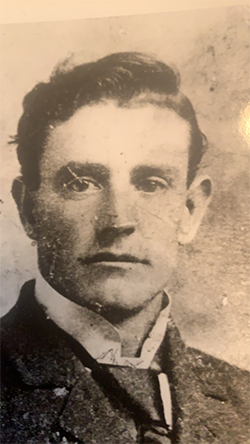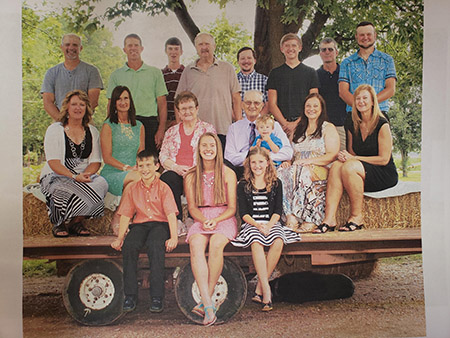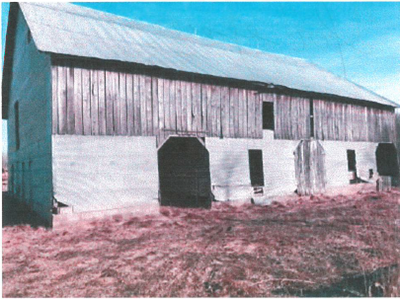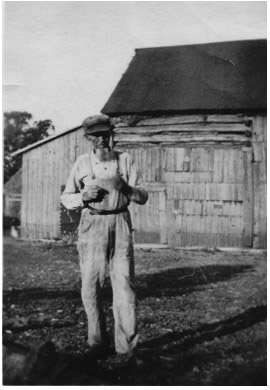Search for Missouri Century Farms
The next application period will open in February 2024. To qualify, the same family must have owned the farm for 100 consecutive years. The line of ownership from the original settler or buyer may be through children, grandchildren, siblings and nephews and nieces, including through marriage or adoption. The farm must be at least 40 acres of the original land acquisition and make a financial contribution to the overall farm income.
Visit the Missouri Century Farms page to learn more.
For a listing of recognized Century Farms, visit the Missouri Century Farms Program History page, select “List of Recognized Century Farms (xls)” and filter by county to see those in Osage County.
For current Osage County Century Farm owners
Please complete this form to ensure we have updated contact information:
Dowler Farm
 The beginning of the Dowler Farm near Cooper Hill, Missouri began when Daniel M. Dowler moved across the Gasconade River from Hope, Missouri with his wife Clemmy Dowler. Since then, three generations of Dowler's since have spent their lives farming that same ground of 117 acres. Jesse Dowler (and Julia), Daniel I. Dowler (and Debra), and Devon Dowler have taken this land, adapted to the current times, and aspire to continue growing. "Improving the land" has always been the Dowler's motto which has brought along a lot of change to the land since September 30, 1908. Throughout the years they have raised hogs, cattle, mules, and crops. As the fourth generation to be blessed with this land, Devon Dowler is looking forward to many more years of improvement to add to the legacy that his family has built. Pictured is Daniel M. Dowler.
The beginning of the Dowler Farm near Cooper Hill, Missouri began when Daniel M. Dowler moved across the Gasconade River from Hope, Missouri with his wife Clemmy Dowler. Since then, three generations of Dowler's since have spent their lives farming that same ground of 117 acres. Jesse Dowler (and Julia), Daniel I. Dowler (and Debra), and Devon Dowler have taken this land, adapted to the current times, and aspire to continue growing. "Improving the land" has always been the Dowler's motto which has brought along a lot of change to the land since September 30, 1908. Throughout the years they have raised hogs, cattle, mules, and crops. As the fourth generation to be blessed with this land, Devon Dowler is looking forward to many more years of improvement to add to the legacy that his family has built. Pictured is Daniel M. Dowler.
Falter Farm
The Falter family farm got its start when Herman and Theresia Wansing Falter purchased 420 acres from Frank Loehner, the son of settlers Henry and Gertrude Loehner, in early 1918. In early 1918, Frank was married to Herman’s sister, Frances Falter Loehner. Herman and Theresia purchased the land with the intent to sell it to two of their sons, one of them being Joseph (Joe) Falter. Joe and Annie Falter then purchased 204 acres from Joe’s parents, Herman and Theresia Wansing alter, in May 1918.
When Joe and Annie bought the acreage in 1918, all farmers used draft horses to work the soil. They raised corn and wheat to feed their six sows and 20 head of cattle. By 1942, they were farming with a John Deere B Tractor. As the years went on, Joe and Annie kept the pioneering spirit alive by being early adopters of electricity when Three Rivers Electric Cooperative appealed to the area’s farmers in the early 1940s. In 1949, they dug a well for indoor plumbing. For more than 50 years, Joe and Annie farmed the land. After retiring, they sold the farm to their youngest son, Norbert and his wife, Anne Rehagen Falter, in 1969.

Throughout the years, Norbert and Anne Falter made many changes to the farm. They increased the acreage to 600 acres by purchasing the original Frank and Elizabeth Schwartze property from Sylvester Wieberg in 1976 to raise more cattle, hogs and row crops. Plus, they rented additional adjoining acreage. They were one of the first farmers in the area to plant soybeans, a cash crop that helped them innovate more. Horses were brought back to the farm in 1992 when their youngest daughter wouldn’t take no for an answer.
In 2009, Norbert and Anne received an Environmental Quality Incentives Program (EQIP) grant from National Resources Conservation Service (NRCS), a program of the United States Department of Agriculture (USDA), to implement intensive grazing systems. Intensive grazing helps improve pasture and forage conditions and increase stocking rates. They separated pastures into smaller lots and drilled more wells to ensure each paddock had water. They continued upgrading their intensive grazing systems until 2018.
The Norbert and Anne Falter family also raised lots of vegetables in a large garden and butchered their own animals for meat. They made liver sausage in a seasoned large wooden dugout brought to the U.S. from Germany. Many local families purchased this famous liver sausage. Dry curing meat was also common for the family. Country cured hams and summer sausage were staples that sustained the family of six children.
Norbert and Anne are excited to pass along the farm to the next generation of Falters! It will be interesting to see what innovations the next 100 years bring.
Kremer Farm
Wilfred H. and Mary Ann Kremer are the current owners of Kremer Farm, a 219 acre farm. It was originally purchased by Adolph J. Kremer who is Wilfred’s father on February 26, 1920. Kremer Farm is located in the Bonnots Mill area.
There are two notable landmarks on Kremer Farm.
 One notable landmark is a barn that was built about 110 years ago. The barn is still standing and used on the farm homestead. The barn was erected around an existing log barn or stable, which is standing in the center of the newer structure. The log structure likely dates from the early settlers, perhaps in the 1840’s or 1850’s.
One notable landmark is a barn that was built about 110 years ago. The barn is still standing and used on the farm homestead. The barn was erected around an existing log barn or stable, which is standing in the center of the newer structure. The log structure likely dates from the early settlers, perhaps in the 1840’s or 1850’s.
The other notable landmark is a rock quarry that is located on the property along Linn Creek, from which limestone rock was quarried and transported to the town of Frankenstein during the construction of the catholic church in 1922-1923. Nearly all stone used in building the church originated from the farm.
Schmitz Farm
The Schmitz Farm started on February 4, 1920 when August and Regina Schmitz purchased the 175.5 acres. It is currently owned and operated by Vernon and Gloria Schmitz.
Schroeder Farm
The Wachtendorf farm was originally settled in Babbtown by Claus Wachtendorf in 1896. The farm started in Osage County where Claus raised cattle, goats, hogs, and chickens.
Pictured is a photo of the old log house that was originally built in the 1800’s. The original log from the home was used to build another barn for the livestock. The house was then added on to with each generation. Some of the original buildings are still in use to this day. Behind the house used to be an orchard with multiple fruit trees along with a larger garden. There is an old road that runs through the farm that was used as the main road to get to the Beck General Store, Post Office, and Black Smith Shop that sat on the north side of the farm. This road ran from Van Cleve to the Mari-Osa-Delta.
 This is a picture of Claus Wachtendorf in front of the original barn that faced north and south which burnt. A new barn was built in its’ place in 1951 facing east and west. This barn is still in use today.
This is a picture of Claus Wachtendorf in front of the original barn that faced north and south which burnt. A new barn was built in its’ place in 1951 facing east and west. This barn is still in use today.
Through the years the farm was passed from Claus Wachtendorf to his son Carl Wachtendorf in 1917. Carl passed it to his daughter Anna Schroeder (Wachtendorf) and husband Otto Schroeder in 1946. Anna passed it to her nephew ED Schroeder (current owner) in 1993.
Edwin (Ed) & late Jerline Schroeder bought the farm in 1993. Ed currently resides in the farmhouse that was built in 1896 on the 330 acres. He continues to raise Registered American Black Herefords, chickens and hay. Their children are Karen, Jason, Stacia and Eric. Jason and his family now own and reside on the land that the general store, post office and black smith shop were located years ago.